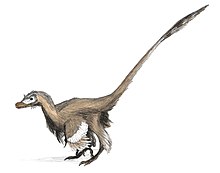Forget Extinct: The Brontosaurus Never Even Existed
by NPR STAFF
Listen to the Story
All Things Considered [4 min 44 sec]
Add to Playlist
Download
Transcript
EnlargeJoshua Franzos/Carnegie Museum of Natural History
Apatosaurus (right, opposite a Diplodocus skeleton at the Carnegie Museum of Natural History in Pittsburgh), is what paleontologist Othniel Charles Marsh actually found when he thought he'd discovered the Brontosaurus.
text size A A A December 9, 2012
It may have something to do with all those Brontosaurus burgers everyone's favorite modern stone-age family ate, but when you think of a giant dinosaur with a tiny head and long, swooping tail, the Brontosaurus is probably what you're seeing in your mind.
Well hold on: Scientifically speaking, there's no such thing as a Brontosaurus.
Even if you knew that, you may not know how the fictional dinosaur came to star in the prehistoric landscape of popular imagination for so long.
It dates back 130 years, to a period of early U.S. paleontology known as the Bone Wars, says Matt Lamanna, curator at the Carnegie Museum of Natural History in Pittsburgh.
Hulton Archive/Getty Images
Othniel Charles Marsh was a professor of paleontology at Yale who made many dinosaur fossil discoveries, including the Apatosaurus — and the fictional Brontosaurus.
The Bone Wars was the name given to a bitter competition between two paleontologists, Yale's O.C. Marsh and Edward Drinker Cope of Philadelphia. Lamanna says their mutual dislike, paired with their scientific ambition, led them to race dinosaur names into publication, each trying to outdo the other.
"There are stories of either Cope or Marsh telling their fossil collectors to smash skeletons that were still in the ground, just so the other guy couldn't get them," Lamanna tells Guy Raz, host of weekends on All Things Considered. "It was definitely a bitter, bitter rivalry."
The two burned through money, and were as much fame-hungry trailblazers as scientists.
It was in the heat of this competition, in 1877, that Marsh discovered the partial skeleton of a long-necked, long-tailed, leaf-eating dinosaur he dubbed Apatosaurus. It was missing a skull, so in 1883 when Marsh published a reconstruction of his Apatosaurus, Lamanna says he used the head of another dinosaur — thought to be a Camarasaurus — to complete the skeleton.
"Two years later," Lamanna says, "his fossil collectors that were working out West sent him a second skeleton that he thought belonged to a different dinosaur that he named Brontosaurus."
But it wasn't a different dinosaur. It was simply a more complete Apatosaurus — one that Marsh, in his rush to one-up Cope, carelessly and quickly mistook for something new.
EnlargeCarnegie Museum of Natural History
This photograph from 1934 shows the Carnegie Museum's Apatosaurus skeleton on the right — wearing the wrong skull.
Although the mistake was spotted by scientists by 1903, the Brontosaurus lived on, in movies, books and children's imaginations. The Carnegie Museum in Pittsburgh even topped its Apatosaurus skeleton with the wrong head in 1932. The apathy of the scientific community and a dearth of well-preserved Apatosaurus skulls kept it there for nearly 50 years.
That Brontosaurus finally met its end in the 1970s when two Carnegie researchers took a second look at the controversy. They determined a skull found in a quarry in Utah in 1910 was the true Apatosaurus skull. In 1979 the correct head was placed atop the museum's skeleton.
The Brontosaurus was gone at last, but Lamanna suggests the name stuck in part because it was given at a time when the Bone Wars fueled intense public interest in the discovery of new dinosaurs. And, he says, it's just a better name.
"Brontosaurus means 'thunder lizard,'" he says. "It's a big, evocative name, whereas Apatosaurus means 'deceptive lizard.' It's quite a bit more boring."








 i aint believing shyt nomore
i aint believing shyt nomore
